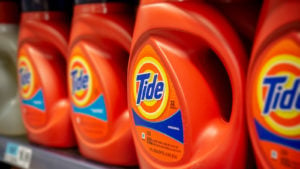Diversified income stocks come from companies with strong fundamentals and proven business models. They have a history of consistent dividend payments and revenue growth. These stocks span various sectors, reducing the risk of relying on a single industry.
Investing in diversified income stocks allows you to build a robust portfolio that generates passive income. They offer an attractive alternative to low-yielding bonds and volatile growth stocks, providing a balance of income and capital appreciation.
I’ve identified seven powerhouse companies that demonstrated their ability to deliver lifelong cash flow. They weathered market downturns and emerged stronger.
So, whether you’re a retiree seeking stable income or a young investor building wealth, diversified income stocks should be on your radar. They offer a solid foundation for your investment strategy.
Johnson & Johnson (JNJ)

Johnson & Johnson (NYSE:JNJ) is a multinational corporation engaged in the research, development, manufacturing, and sale of a broad range of products in the healthcare field.
The company has a strong track record of rewarding shareholders, with 62 consecutive years of dividend growth. JNJ currently pays a quarterly dividend of $1.24 per share, amounting to an annual dividend of $4.96 and an attractive forward yield of 3.4%. Fortune recently recognized the company’s commitment to innovation, which named Johnson & Johnson to its 2024 list of America’s Most Innovative Companies.
The company’s focus on developing cutting-edge healthcare solutions across its MedTech and Innovative Medicine businesses positions it well for future growth. Additionally, JNJ’s strong financial position, with a cash balance and a free cash flow of $18.7 billion over the past 12 months, provides flexibility for further investments and potential dividend increases. This then makes it one of those diversified income stocks to consider.
Procter & Gamble (PG)

Procter & Gamble (NYSE:PG) is a leading consumer goods company offering a wide range of products, including beauty, grooming, health care, home care, baby products and more.
PG has strong income potential with 68 consecutive years of dividend growth. PG currently pays a quarterly dividend of $1.0065 per share, amounting to an annual dividend of $4.03 and a forward yield of 2.4%. The company reported strong results for the first quarter of fiscal year 2024, with net sales increasing by 6% and organic sales growing by 7%. Diluted net earnings per share increased by 17% to $1.83.
The company’s focus on product innovation, cost savings, and productivity improvements allows it to deliver strong results despite unfavorable foreign exchange rates. PG’s diverse product portfolio, which includes well-known brands like Tide, Pampers and Gillette, provides a stable foundation for future growth.
Coca-Cola (KO)

Coca-Cola (NYSE:KO) is best known for its flagship Coca-Cola brand but also owns a variety of other non-alcoholic beverages.
KO reported strong earnings in the first quarter and revenue that beat analysts’ expectations, driven by increased demand for its Fanta and Fairlife beverages. The company raised its full-year organic revenue outlook to a range of 8% to 9%, up from the previous range of 6% to 7%. Coca-Cola’s global unit case volume grew by 1% in the quarter.
With a market capitalization of $272.8 billion and a consistent track record of dividend growth spanning 62 years, Coca-Cola remains an attractive option for income-focused investors. The stock’s current dividend yield of 3% and a five-year beta of 0.59, indicating lower price volatility compared to the market average, further strengthen the bull case.
Additionally, analysts maintain a strong buy consensus rating for the stock, with an average price target of $68.58, suggesting an upside potential of 8% from the current price.
Realty Income (O)

Realty Income (NYSE:O) is a real estate investment trust, or REIT, known for its monthly dividend payments. It owns and manages a diverse portfolio of commercial properties under long-term net lease agreements.
O reported strong operating results for the first quarter of 2024. The company’s revenue increased by 24.3% year-over-year to $1.26 billion, driven by the acquisition of new properties and the merger with Spirit Realty Capital. Net income available to common stockholders was $129.7 million, or 16 cents per share, while adjusted funds from operations available to common stockholders was $862.9 million.
The company’s diversified portfolio of over 15,450 commercial properties across various industries and geographies provides a stable and resilient foundation for long-term growth. With a current annual dividend of $3.16 per share and a forward yield of 6%, Realty Income offers an attractive income stream for investors. This makes it one of those diversified income stocks to consider.
PepsiCo (PEP)

PepsiCo (NASDAQ:PEP) is a global food and beverage leader with a portfolio that includes Frito-Lay, Gatorade, Pepsi-Cola, Quaker, and Tropicana. It operates in more than 200 countries and territories.
PEP reported strong quarterly earnings and revenue that beat analysts’ expectations, despite facing challenges in its home market. The company’s net income rose to $2.04 billion, or $1.48 per share, while net sales increased by 2.3% to $18.25 billion.
Moreover, the company’s attractive dividend yield of 3.3% and its 52-year history of consecutive dividend increases make it a compelling choice for income-focused investors. With analysts maintaining a buy consensus rating and an average price target of $188.15, suggesting a potential upside of 15% from the current price.
PEP presents a promising investment opportunity for those seeking growth and income. I think it’s one of those stocks that all investors should have on their radars as a potential investment.
Southern Company (SO)

Southern Company (NYSE:SO) is a leading energy company serving the southeastern U.S. It operates through segments such as electric utilities, gas utilities, and other non-utility operations.
The company reported robust first-quarter 2024 earnings of $1.1 billion, or $1.03 per share, up from $862 million a year ago. This performance was driven by higher utility revenues and investments in state-regulated utilities. SO’s revenue increased by 2.6% year-over-year to $6.6 billion in the quarter.
The recent commercial operation of Plant Vogtle Unit 4 positions Southern as the largest generator of clean energy in the U.S., aligning with growing demand for sustainable power sources. The company’s 3.7% dividend yield and 23-year history of dividend growth make it attractive for income-seeking investors. With a strong presence in the Southeast, SO is positioned to benefit from the region’s economic growth and increasing energy demands, particularly from data centers.
Analysts maintain a buy consensus with a $75.79 price target.
Verizon (VZ)

Verizon (NYSE:VZ) is a telecommunications giant providing wireless and wireline communication services to consumers, businesses, and government entities. It is a leading player in the U.S. telecom market.
The company reported solid Q1 2024 results, with total wireless service revenue growing 3.3% year-over-year to $19.5 billion. This growth was driven by pricing actions, higher premium plan adoption, and expansion of its fixed wireless subscriber base.
Verizon’s focus on broadband is paying off, with 389,000 total broadband net additions in Q1, including strong fixed wireless growth. The company has added over 3 million broadband subscribers in the last two years.
With a generous dividend yield of 6.5% and 19 years of consecutive dividend growth, Verizon offers attractive income potential for investors. The company’s strong cash flow generation, with $2.7 billion in free cash flow for Q1, supports its dividend sustainability despite its high payout ratio, thus making it one of those diversified income stocks.
On the date of publication, Matthew Farley did not have (either directly or indirectly) any positions in the securities mentioned in this article. The opinions expressed are those of the writer, subject to the InvestorPlace.com Publishing Guidelines.
On the date of publication, the responsible editor did not have (either directly or indirectly) any positions in the securities mentioned in this article.
Matthew started writing coverage of the financial markets during the crypto boom of 2017 and was also a team member of several fintech startups. He then started writing about Australian and U.S. equities for various publications. His work has appeared in MarketBeat, FXStreet, Cryptoslate, Seeking Alpha, and the New Scientist magazine, among others.
